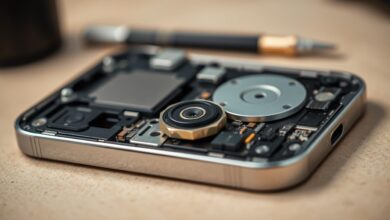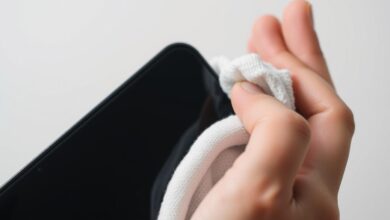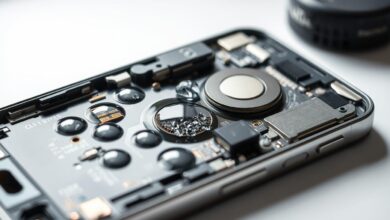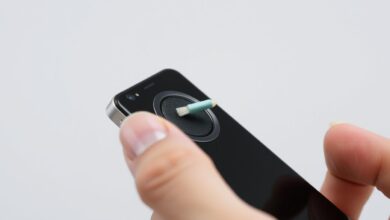how to get water out of phone speaker
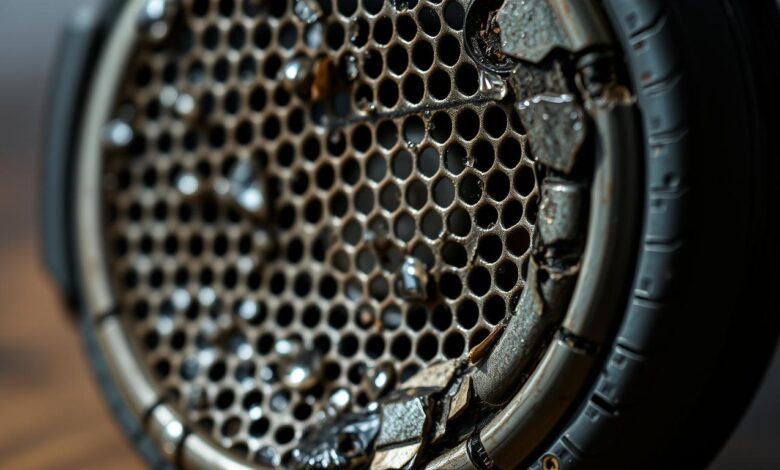
Water damage can harm your device, especially the speaker. If your water damaged phone speaker gets wet, act fast. First, turn off your phone to avoid short circuits.
To dry your phone’s speaker, you can use a microfiber cloth. You can also play low-frequency sounds or use apps to remove water. For serious cases, put your phone in a bag with silica gel packets. For more help, visit fixmyspeakers.com to find sounds that can help.
Key Takeaways
- Turn off your phone immediately if it gets wet.
- Dry off any visible water with a microfiber cloth.
- Use apps or websites to play sounds that help eject water.
- Avoid using a blow dryer or putting your phone in rice.
- For severe cases, use silica gel packets to dry out your phone.
Understanding the Risks of Water in Phone Speakers
Water in your phone’s speaker can cause serious damage. Water and electronics don’t mix well, and speakers are especially at risk. Knowing the risks helps prevent damage.
How Water Damages Phone Speakers
Water harms phone speakers by corroding parts and messing with the sound. This can lead to audio distortion or muffled sound. The speaker’s parts get damaged when water gets in.
As waterlogged phone speaker problems get worse, they can’t be fixed easily. It’s not just about drying the speaker. You might need to replace damaged parts.
Common Ways Water Gets Into Phone Speakers
Water gets into phone speakers when they fall in water or get wet in the rain. Using your phone in humid places or near water also risks damage. Water can get into the phone’s openings, like the speaker grills.
Knowing these risks helps you avoid them. Use waterproof cases or be careful in wet places. Keeping your phone dry is the best way to protect its speaker.
Signs Your Phone Speaker Has Water Damage
Water damage to your phone’s speaker can show up in many ways. Knowing these signs is crucial to fix the problem. Water can mess with the sound quality or even stop the speaker from working.
Audio Distortion and Muffled Sound
One early sign is audio distortion or muffled sound. If your phone’s speaker sounds unclear or fuzzy, water might be the culprit. The distortion can be mild or very bad, depending on the water amount.
Crackling or Popping Noises
Crackling or popping noises when playing audio are another sign. Water can make the speaker’s diaphragm vibrate oddly. Hearing these sounds means your speaker needs help.
Complete Speaker Failure
In bad cases, water damage can make the speaker stop working. If your phone’s speaker doesn’t make any sound, you must act fast. Trying to remove water might fix a wet phone speaker and get it working again.
Spotting these signs early helps you fix the problem quickly. If you’re facing these issues, try phone speaker water removal to get your sound back.
Immediate Actions to Take When Your Phone Gets Wet
When your phone gets wet, you must act fast. This can help avoid damage and keep your phone working. Quick action can stop corrosion and protect your phone’s parts, like the speaker.
Power Off Your Device Immediately
Turning off your phone right away is key. It stops short circuits from happening. Don’t turn it back on until it’s dry to avoid more damage.
Remove Case and External Components
Take off the phone case and SIM card. This lets your phone dry faster. It also lets you check for damage. Be careful not to hurt your phone more.
Avoid Common Mistakes
Don’t charge your phone or use a hair dryer to dry it. These actions can harm your phone. Instead, use gentle methods and be patient. A study warns that heat can damage your phone.
“Using heat to dry out a wet phone is a risky move that can cause more damage than good.”
| Action | Benefit | Risks |
|---|---|---|
| Powering off immediately | Prevents short circuits | None if done correctly |
| Removing case and components | Aids in drying, exposes damaged areas | Potential for additional damage if not done gently |
| Avoiding heat sources | Prevents pushing water further in, reduces risk of damage | May require more patience |
How to Get Water Out of Phone Speaker Using Sound Frequencies
Sound frequencies can help get water out of your phone’s speaker. This method uses audio tones to push water out of the speaker grills. It might save your device from water damage.
To use sound frequencies, you can use apps or online tools. These tools create sound waves that remove water from your phone’s speaker.
Using Water Eject Apps
Many apps can generate sound frequencies to eject water from your phone’s speaker. These apps produce specific sound frequencies that work well. To use them, download and install a good app, open it, and play the sound.
It’s best to place your phone on a flat surface and turn the volume up. This ensures the sound works well.
Popular apps include Water Eject and Speaker Cleaner. They work on both Android and iOS, making them easy to find.
| App Name | Platform | Rating |
|---|---|---|
| Water Eject | Android, iOS | 4.5/5 |
| Speaker Cleaner | Android, iOS | 4.7/5 |
Using Online Water Ejection Tools
If you don’t want to download an app, online tools are available. They work like apps, using sound frequencies to remove water. Just search for “water ejection sound” or “phone speaker water removal tool” online.
Make sure your phone’s volume is up. Play the sound to remove water from your phone’s speaker.
How Sound Frequencies Expel Water
Sound frequencies work by creating vibrations. These vibrations help push water out of the speaker grills. It’s a good way to remove water and prevent damage.
Understanding how sound frequencies work can help save your phone’s speaker. Use an app or online tool to generate the right frequency. This will vibrate the water out of the speaker.
Using the Rice Method Effectively
The rice method is a popular way to dry wet phones. But, it only works if you do it right. When your phone’s speaker gets wet, you must act fast to avoid damage.
Proper Technique for the Rice Method
To dry your phone’s speaker with rice, first turn off your device. Then, put your phone in a container with uncooked rice. Make sure it’s fully covered by rice.
The rice pulls moisture out of your phone. It’s best to leave your phone in the rice for at least 48 hours. This lets it dry completely.
Limitations and Misconceptions
Even though rice can help, it’s not always enough. Some people think rice can fix any water damage. But, it might not work if the water has already harmed your phone’s parts.
Rice also can’t dry out your phone’s internal parts as fast as other methods. This might cause corrosion over time.
| Method | Effectiveness | Time Required |
|---|---|---|
| Rice Method | Moderate | 48 hours |
| Silica Gel | High | 24-48 hours |
| Compressed Air | Low to Moderate | Immediate |
It’s important to know the limits of the rice method. For a waterlogged phone speaker, using rice with other drying methods might work better.
Silica Gel and Desiccants for Water Removal
Removing water from your phone’s speaker can be tricky. Yet, silica gel and other desiccants are often overlooked but very effective. These materials absorb moisture, helping to dry out your phone’s speaker and fix its sound.
How Desiccants Work
Desiccants, like silica gel, soak up moisture from the air. They’re perfect for drying wet electronics. By placing silica gel near your phone’s speaker, you can remove the moisture causing problems.
Proper Application for Phone Speakers
To use desiccants, put silica gel packets in a sealed container with your phone. This could be a plastic bag or airtight container. The desiccant will soak up moisture from the air and your phone. Be patient, as drying can take hours or days, depending on the damage.
Where to Find Effective Desiccants
You can find silica gel packets in many places, like shoe boxes or electronic packaging. You can also buy them online. Look for products labeled as moisture-absorbing or desiccants. They’re available in hardware stores, online, or home goods stores. Using silica gel or other desiccants can help fix your wet phone speaker and improve its sound.
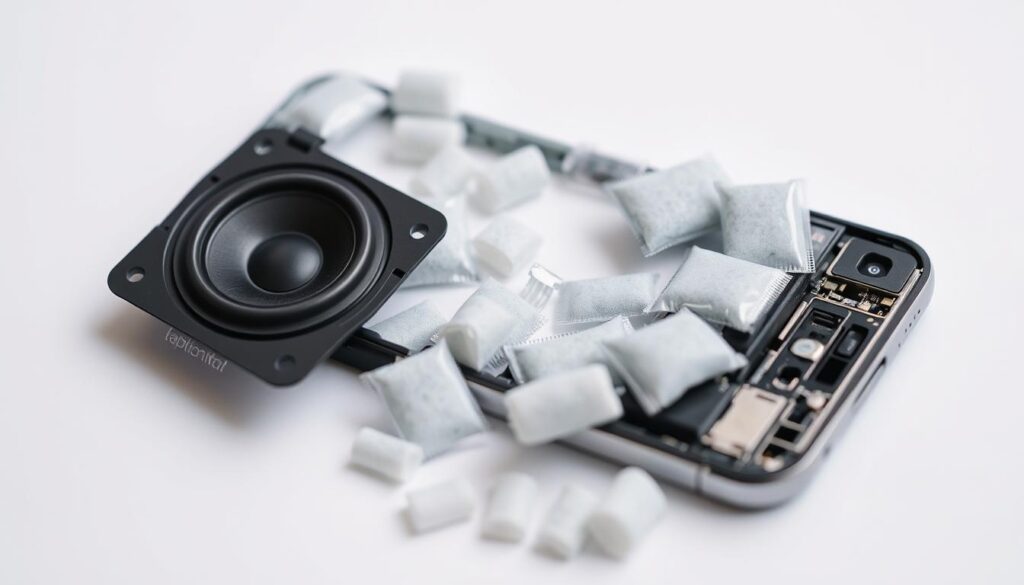
Using Compressed Air to Remove Water
Removing water from your phone’s speaker can be tricky. But using compressed air is a method that’s often overlooked. It can be very effective if done right. Compressed air can push out water droplets stuck in the speaker grills or small crevices, potentially saving your phone from water damage.
To use compressed air safely, it’s important to follow the right steps. This way, you can avoid causing more harm to your phone.
Safe Techniques for Using Compressed Air
To safely use compressed air, follow these steps:
- Hold your phone upright and ensure it’s on a stable surface.
- Use short, gentle bursts of compressed air to avoid pushing water further into the phone.
- Keep the can upright to prevent liquid from coming out.
- Spray the compressed air into the speaker grills and other openings where water might be trapped.
By following these steps, you can effectively remove water from your phone speaker without causing additional harm.
Potential Risks and Precautions
While compressed air can be helpful, there are risks involved. Using too much pressure or holding the can at an angle can cause more harm than good. Here are some precautions to take:
- Avoid spraying the compressed air too closely or directly into the speaker, as this can damage the internal components.
- Be cautious not to tilt the can, as this can release liquid propellant, which can damage your phone’s internal electronics.
- Limit the number of bursts to avoid excessive pressure buildup inside the phone.
If your phone’s speaker is water-damaged, it’s crucial to be gentle and cautious. This way, you can avoid causing more damage when trying to remove the water.
Gravity Method: Positioning Your Phone for Water Drainage
Gravity can help remove water from your phone’s speaker. By placing your device in certain ways, water can drain out. This reduces the chance of damage.
To get the most out of gravity, knowing how to position your phone is key. Different phones have speakers in different spots. So, the best position varies by phone model.
Optimal Positions for Different Phone Models
Speakers are placed differently in various phones. Some have speakers at the bottom, while others are on top or sides. To use gravity well, you need to place your phone so water can flow out.
If your phone’s speakers are at the bottom, hold it upside down. This helps water drain. For phones with top or side speakers, adjust the position to help water flow out.
Combining Gravity with Gentle Tapping Techniques
Gently tapping your phone can also help remove water. Tapping, along with gravity, can make water removal more effective. But, be careful not to tap too hard to avoid damage.
Tap around the speaker grill with your finger or a soft tool. This gentle action can help water move out. But, don’t press too hard, as it might push water deeper into your phone.
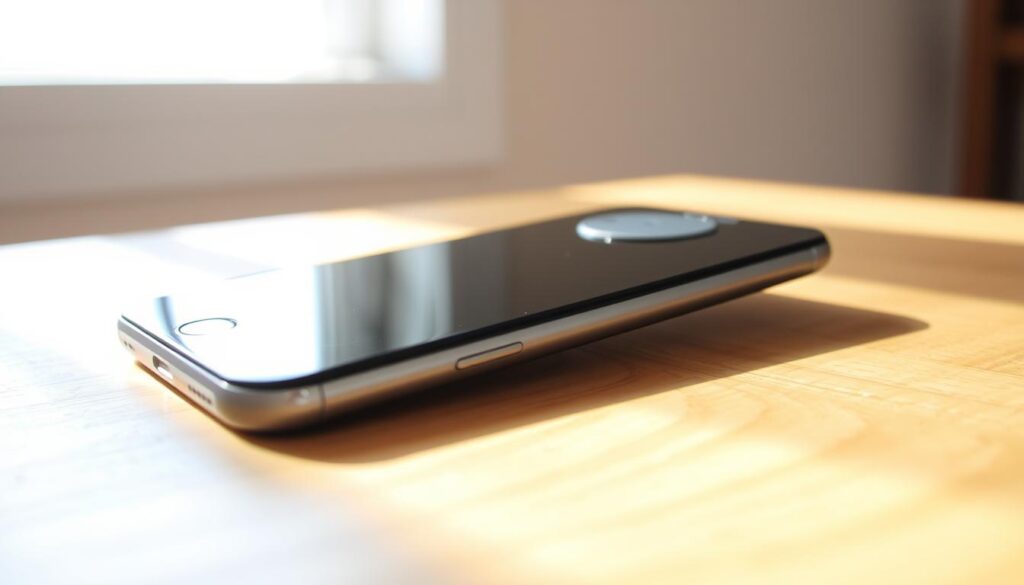
Using a Vacuum to Extract Water
A vacuum can be a good tool for getting water out of your phone’s speaker. It works well if used the right way, without harming your phone.
Low-Power Vacuum Methods
For phone speaker water removal, it’s key to use low-power vacuum methods. High suction can harm your phone’s inside parts.
Try using a handheld vacuum with adjustable suction. Set it to the lowest power. Then, gently put the nozzle near the speaker. Slowly move it around to pull out the water.
Safety Precautions When Using Vacuums
When drying a waterlogged phone speaker with a vacuum, be careful. Don’t use too much suction power. It might pull debris into your phone or damage the speaker.
Also, make sure the vacuum nozzle is far enough from the speaker. This way, you won’t push water deeper into your phone.
| Precaution | Description |
|---|---|
| Low Suction Power | Use the lowest suction power setting to avoid damaging internal components. |
| Safe Distance | Keep the vacuum nozzle at a safe distance to prevent pushing water further in. |
| Avoid Liquids | Ensure the vacuum itself does not come into contact with liquids to prevent damage. |
Heat Methods: Using Warm Air Safely
Heat can help fix a wet phone speaker if used carefully. Warm air can evaporate water in your phone’s speaker. But, be careful not to overheat, as it can harm your device.
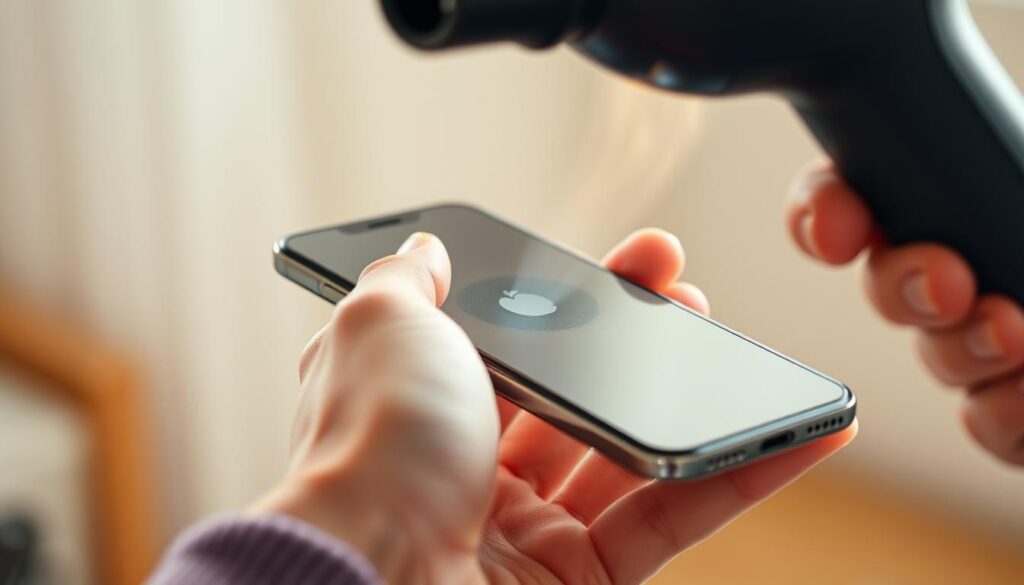
Hair Dryer Technique
Using a hair dryer is a common way to dry a phone speaker. Start by setting the dryer to its lowest heat. Hold it at least 6 inches from your phone. Move it back and forth to spread the heat evenly.
This method works well, but be careful not to overheat your phone.
Warm Environment Method
Another way is to put your phone in a warm place. You can place it near a heater or in a warm, dry spot. This method helps evaporate moisture without direct heat damage.
It might take longer than using a hair dryer, so be patient.
Avoiding Heat Damage
While heat can be helpful, it also poses risks. Too much heat can damage your phone’s parts. To avoid this, use low heat settings and keep the heat source far away.
Watch your phone closely while drying it. If it gets too hot or shows warning signs, stop right away.
| Method | Precautions | Effectiveness |
|---|---|---|
| Hair Dryer | Low heat, safe distance | High |
| Warm Environment | Avoid direct heat, monitor temperature | Moderate |
Waterproof Phones: Limitations and Special Considerations
Waterproof smartphones are getting more popular. It’s key to know what they can and can’t do. They protect against water damage, but there are things to remember.
IP Ratings Explained
IP ratings show how well a device is sealed against dirt and water. The first number is for solid protection, the second for liquids.
A phone with an IP68 rating is dustproof and can handle being underwater for up to 30 minutes at 1 meter, says the maker.
Water Resistance vs. Waterproof
It’s important to know the difference between water resistance and being waterproof. Water resistance means a device can handle water in some situations, but it’s not completely safe from water damage. Waterproof means a device is fully sealed against water, which is rare in phones.
Most phones are water-resistant to some extent. How well they handle water depends on how deep and long they’re exposed.
Maintenance of Water-Resistant Features
To keep your phone’s water-resistant features working, check and clean the SIM card tray and other openings often. Don’t let your phone get too hot or cold, or expose it to harsh chemicals. These can damage the seals.
| Maintenance Task | Frequency | Importance Level |
|---|---|---|
| Inspect SIM card tray | Monthly | High |
| Clean phone ports | Every 3 months | Medium |
| Avoid extreme temperatures | Ongoing | High |
Knowing the limits and taking good care of your waterproof phone can help avoid water damage. This includes protecting your device’s speaker and other parts.
When to Seek Professional Help
Even after trying DIY fixes, some water damage needs a pro. If you’ve tried to remove water from your phone speaker but still face problems, it’s time to call a professional.
Water damage might seem minor at first but can cause big problems if not fixed right. Knowing when to get help is key to avoiding bigger issues.
Signs of Serious Water Damage
Severe water damage shows in several ways. Look out for audio distortion, speaker failure, or corrosion inside. If your phone shows these signs, it’s likely too damaged for DIY fixes.
- Persistent audio issues despite trying DIY fixes
- Visible corrosion or mineral deposits inside the phone
- Complete failure of the speaker or other critical components
What Professional Repair Services Can Do
Experts have the skills and tools to fix water damage. They can inspect, clean, and replace damaged parts. Getting professional help boosts your phone’s chances of being fixed.
Cost Considerations vs. DIY Methods
DIY fixes are cheap and work for small problems. But, pros are pricier but more reliable for serious damage. Think about the cost and the chance of fixing your phone. Often, fixing it professionally is cheaper than buying a new one.
Aftercare: What to Do Once Water Is Removed
Removing water from your phone speaker is just the first step. Proper aftercare is key to keeping your device healthy. After drying your phone speaker, follow these steps to keep it working well.
Testing Speaker Functionality
To check if your phone speaker works after water removal, play music or a video with clear sound. Listen for any distortion or muffled sound. If you hear issues, it could mean water or damage is still present. Testing your speaker with different types of audio can help identify any problems early on.
Also, check both the speaker and the receiver during calls to make sure they’re working right.
Monitoring for Delayed Damage
Even after removing water, damage can still happen later. Corrosion can develop over time, harming your phone’s parts. Regularly inspect your phone for signs of corrosion or water damage, like discoloration around the SIM card slot or charging port.
Watch your phone’s performance closely. If it acts strangely, like random reboots or unresponsive touchscreens, it might be damaged inside.
Preventative Maintenance
To avoid water damage in the future, use a waterproof case or pouch, especially near water. Clean your phone’s ports and speakers often to stop debris buildup and problems.
Also, stay aware of your surroundings and keep your phone away from water. This can greatly lower the chance of water damage.
Conclusion: Preventing Future Water Damage
Now that you know how to fix a wet phone speaker, it’s time to prevent water damage. Being careful and taking simple steps can help a lot. This way, you can keep your device safe from water.
Using a water-resistant case is a good idea. Also, be careful around water, like pools or kitchens. Check your phone’s seals and ports often for damage. This helps catch problems early.
By following these steps and the methods to fix a wet phone, your phone will be safer. Protecting your phone from water is an ongoing task. But with the right steps, you can keep your device working well.
FAQ
How do I know if my phone speaker has water damage?
Look out for audio distortion, muffled sound, or crackling noises. If your speaker fails after getting wet, it’s damaged.
Can I use any sound frequency to remove water from my phone speaker?
No, you need specific sound frequencies to remove water. Use apps or online tools that generate these frequencies.
Is the rice method effective for drying out a wet phone speaker?
The rice method can work, but it’s not perfect. Submerge your phone in rice, making sure it’s fully covered. But, rice dust can harm your phone, and it’s not always effective.
How do desiccants work to dry out a wet phone speaker?
Desiccants, like silica gel, soak up moisture. Place your phone near or with desiccants to dry out the moisture.
Can I use a hair dryer to dry out my phone speaker?
Yes, but be careful. A low or cool setting on a hair dryer can help dry water. But, avoid high heat to prevent damage to your phone.
Are waterproof phones completely immune to water damage?
No, waterproof phones have limits. Know the difference between water resistance and being waterproof. Regularly check your phone’s water-resistant features.
When should I seek professional help for water damage?
If DIY methods don’t work, or if you’re unsure, get professional help. Experts can fix damage that DIY can’t.
How can I prevent future water damage to my phone speaker?
Use protective cases, stay aware of your surroundings, and avoid water. Regularly check your phone’s water-resistant features to prevent damage.
What should I do after removing water from my phone speaker?
Test your speaker, watch for delayed damage, and maintain your phone. This ensures it works well.
Can I use compressed air to remove water from my phone speaker?
Yes, but carefully. Use compressed air to avoid pushing water in or damaging your phone. Spray from a safe distance and keep the can upright.
Is it safe to use a vacuum to extract water from my phone speaker?
Using a low-power vacuum is safe if done right. Be careful not to damage your phone’s parts and avoid strong suction.
